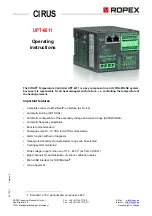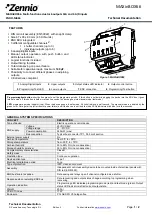
Mounting and installation
Page 11
UPT-6011
Version 5
2. Mount the CIRUS
®
Temperature Controller on a standard top hat rail (TS35 rail according to DIN EN 50022) in
the electrical cabinet. If several controllers are mounted on one rail, the minimum clearance specified in
section 10 "Technical data" on page 73 must be allowed between them.
3. Wire the system in accordance with the instructions in section 6.1 "Installation notes" on page 10, section 6.6
"Wiring diagram (standard)" on page 15, and the ROPEX Application Report. The information provided in
section 6.1 "Installation notes" on page 10 must also be observed.
Wires used for control or measuring connections must always be laid inside the building.
4. An overcurrent protective device with a maximum rating of 10 A must be fitted when the device is installed, e.g.:
- Miniature circuit breaker to EN 60898 (B, C, D, K, or Z characteristic)
- Miniature circuit breaker to UL 489 (*) (B, C, D, K, or Z characteristic)
- Fuse gG to IEC 60269
- Class CC or Class J fuse to UL 248 (*)
The overcurrent protective devices marked (*) should be used in installations conforming to UL standards.
If one such device is not adequate for the heatsealing application, two separate overcurrent protective devices
should be provided – one for the controller and one for the application (
ROPEX Application Report).
The overcurrent protective device must be located directly adjacent to the controller.
The minimum possible specification for this device is indicated in the ROPEX Application Report based on the
calculated currents. If a larger overcurrent protective device is fitted, you must match the current carrying
capacity of the other components accordingly (e.g. cables, impulse transformer etc.).
5. A disconnecting device must be provided when the system is installed; it must be marked as belonging to the
system and fitted in a readily accessible position.
If a miniature circuit breaker is used, it can also perform the function of this device.
6. Connect the CIRUS temperature controller to the EtherNet/IP
TM
scanner using a suitable (standard compliant)
cable.
Check that all system connections – including the terminals for the impulse transformer windings
– are securely attached.
7. Make sure the wiring conforms to all relevant national and international installation regulations.
!












































